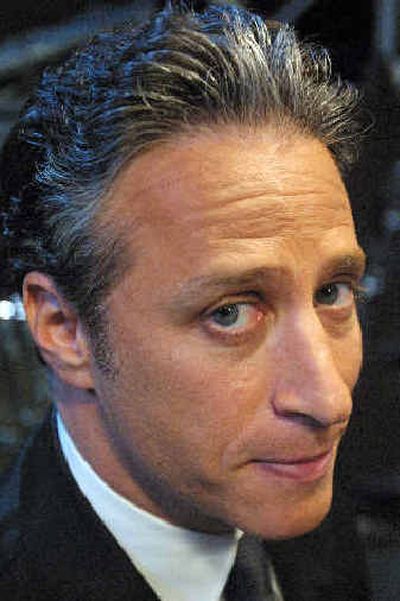Students study this textbook

Sixteen-year-old Angel Varak-Iglar saw the new book, “America (The Book): A Citizen’s Guide to Democracy Inaction” (Warner Books), at Target a few weeks ago and immediately was drawn to it.
Never mind that the best-selling satire is chock full of four-letter words and bodily functions. Varak-Iglar, a junior at Ironwood Ridge High School in Tucson, Ariz., and a self-described “history junkie – kind of,” bought it and says her friends are picking it up too despite the $24.95 price tag.
“It’s kind of just becoming a ‘thing’ now,” she says. “It’s the new book to read.”
“America” by Jon Stewart and a team of writers from his popular “The Daily Show “on Comedy Central is a pitch-perfect send-up of glossy-bound history textbooks, hilarious but off-color.
Not surprisingly, it appeals to high schoolers who have spent years slogging through the books it spoofs.
Stewart’s fan base of people in their 20s and 30s likely will be the biggest buyers, but he has legions of younger fans too. And like Varak-Iglar, many are sharing it with friends.
“I would absolutely expect that it’s going to show up in schools,” says Justin Torres of the Thomas B. Fordham Foundation, a Washington think tank. “It’s going to be passed around, and (kids) will probably try to bait their teachers with it.”
Most teachers say they won’t take the bait but might look the other way if students are learning about history or current events.
“If it’s going to get some kids interested, great,” says Marty Creel, a former history teacher who now oversees social studies programs for schools in Montgomery County, Md. “Are we going to recommend it at the school system? No.”
The book reserves its most audacious gag for the U.S. Supreme Court, posing the nine justices as naked paper dolls, waiting to be dressed in robes. (Their heads are grafted to photos from a nudist Web site.)
Even if that sort of thing gets kids interested in history, it makes the book off-limits for school, says Peggy Altoff, vice president of the National Council for the Social Studies. “There’s no way that a teacher should bring in the picture of the Supreme Court justices disrobed, although an adult might find that humorous.”
Teachers say they often bring in spoofs or unorthodox treatments of history to get kids interested. Altoff remembers reading her students excerpts from a book called “One Night Stands With American History.”(Perennial Currents, $12.95) “It’s full of phenomenal stories, and it’s fairly well-documented,” she says.
But she adds, “I never took the book and held it up in class.”
Jesus Garcia, the council’s president and author of “Creating America,” (Houghton Mifflin College Div; $78.60) a popular American history textbook, says teachers are unlikely to risk their jobs by using racy materials. “In this day and age when teachers are being criticized for not being on task and teaching what they’re supposed to be teaching, I’d be very hesitant to bring in something off-color,” he says.
Torres, a contributor to the new book, “The Mad, Mad World of Textbook Adoption,” says he’s all for anything that “has the counterintuitive effect of making people more interested in American history and civics.
“‘Naked Supreme Court justices’ is just funny – period.”
Under their breaths, many teachers agree.
The power of humor can’t be underestimated, says Kari Bluff, who teaches English at King City (Calif.) High School. “I think many teachers miss the boat on that.”
Though she has let her students take a peek at her copy of “America” – “They see worse, and they hear worse,” she says – Bluff won’t use it in class with the exception of an excerpt or two.
But she’s hoping that someday, somewhere, a student will hear a historical reference and say, “Oh, I saw that in that book, the one with the naked Supreme Court justices!”
Bluff and others say that sort of humor helps many students connect with what they’re learning.
“What I see with a lot of education is that kids leave the classroom and see absolutely no applicability to real life today,” she says.
“Daily Show” executive producer and “America” co-author Ben Karlin says, “You can’t write a book like that and not have an abiding interest, if not a passion, for history and civics.”
The book “makes people aware of how dull the stuff is that our kids are reading. That’s a huge service,” says Joy Hakim, author of “Freedom: A History of US,”(Oxford University Press; $40) an acclaimed series of history texts. Hakim has been a vocal critic of most textbooks, saying they water down vital, exciting subjects.
“History is heroes, villains, adventures,” she says. “How have we made it dull?”
The profanity “bothers me a little bit. I still believe in having respect for your institutions.” But, she adds, “I like the idea of making fun of things.”
Trev Jones, book review editor for School Library Journal, says it would be unusual for school libraries to carry the book since most public libraries probably will carry it.
Asked if he’s pleased that high schoolers might develop an interest in history by reading such a naughty book, Karlin says, “Absolutely.” But he adds: “We would never say in any way that our goal is to educate or inform.”
Varak-Iglar hasn’t gotten any disapproving looks from teachers but says, “I haven’t exactly been running around waving it in the air.”